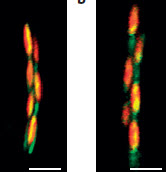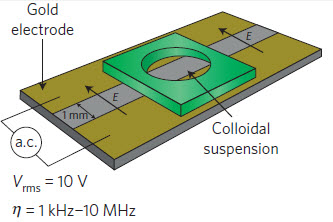Stretching when zapped by an electric current, muscle chains could mobilize microbots
November 12, 2014

Actuation of microscale fibers by alternating-current electric fields: (a) Ordered fiber before application of the electric field. (b) Structure during application of the electric field. (Scale bar, 3 micrometers) (Credit: Aayush A. Shah et al./Nature Materials)
University of Michigan (UM) researchers have developed chains of self-assembling particles that could serve as electrically activated muscles that could move microbots (microscopic robots).
These microbots could come in handy in medicine, manufacturing, and other areas. But there are several challenges, like building the microbots and making them mobile.
For the mobile part, Michael Solomon, a UM professor of chemical engineering, and his group started with particles with diameters of about a hundredth the width of a strand of hair.
They stretched these particles into football shapes and coated one side of each football with gold. The gilded halves attracted one another in slightly salty water.
The particles spontaneously formed short chains of overlapping pairs, averaging around 50 or 60 particles to a chain. When exposed to an alternating electric field, the chains seemed to add new particles indefinitely and the chains stretched by roughly 36 percent, like microscopic muscles.

Schematic of the AC electric field device (credit: Aayush A. Shah et al./Nature Materials)
“You could imagine many of these fibers lining up with the electric field and producing locomotion by expanding and contracting,” said Sharon Glotzer, the Stuart W. Churchill Professor of Chemical Engineering, whose team developed computer simulations that helped explain how the chains grew and operated.
The force generated by the fibers is about 1,000 times weaker than human muscle tissue per unit area, but it may be enough for microbots. “If we can get the chains to swarm together, we can get them to lift loads, move around, do things that biological muscles do,” Solomon said.
Minuscule muscled robots may be many years away, but more immediately, the particles could enable electronics that rewire on demand. “These chains are essentially wires, so you could assemble them into a circuit for reconfigurable electronics,” said Solomon.
The study appeared in the journal Nature Materials. The research was supported by the U.S. Army Research Office, the Assistant Secretary of Defense for Research and Engineering, and the U.S. Department of Defense.
Michigan Engineering | Shape-Shifting Micro Muscles Will Pump You Up | MconneX | MichEpedia
Abstract of Actuation of shape-memory colloidal fibres of Janus ellipsoids
Many natural micrometre-scale assemblies can be actuated to control their optical, transport and mechanical properties, yet such functionality is lacking in colloidal structures synthesized thus far. Here, we show with experiments and computer simulations that Janus ellipsoids can self-assemble into self-limiting one-dimensional fibres with shape-memory properties, and that the fibrillar assemblies can be actuated on application of an external alternating-current electric field. Actuation of the fibres occurs through a sliding mechanism that permits the rapid and reversible elongation and contraction of the Janus-ellipsoid chains by ~36% and that on long timescales leads to the generation of long, uniform self-assembled fibres. Colloidal-scale actuation might be useful in microrobotics and in applications of shape-memory materials.